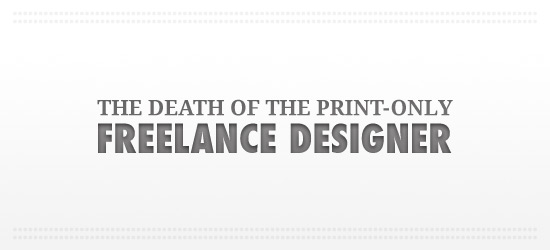If you're looking to hire a development firm to build you a mobile or web app, this Quick Reference Guide is a must-have.
The Death of the Print-Only Freelance Designer
DesignThe print-only freelance designer is a dying breed. There, I said it. If you’re a freelance designer who doesn’t have web-related skills, you best add that arrow to your quiver or you’re going to be left in the dust. Now, it’s worth noting that I’m not saying “print design is dead” or “identity design is dead”. As long as there are businesses, artists, musicians and the like, graphic designers will be needed. However, freelance designers who only operate in the print realm aren’t long for this world.

The digital realm is growing and spreading, and at the expense of the print world. As the opportunities for print work shift over to digital work, so do those print jobs. The numbers show the shift: Amazon sold 143 ebooks for every 100 hardcover books in the second quarter of 2010. In the music industry, album sales fell 12.7% in 2009 while digital singles rose 8.3% and digital albums rose 16.1% (source). These are only two industries, but two big ones – and they point towards the growing trend towards digital over print. It should be noted that overall, people still currently buy more physical albums and physical books, so it’s not like we should erase the section of our brains that holds our print design information right now. However, the numbers don’t lie: digital is growing, print is declining.
Hit the jump for the full article!
Back in the day, print design was king. We started with cave drawings in rock and moved on to books and other print design. In 1991, the Internet was introduced and in 1993, the first proper web browser was introduced; but with the Internet in its infancy, print design wasn’t really threatened. In 2010 however, the large majority of the Western world uses the Internet on a daily basis, plus we have amazing digital devices like the iPad, Kindle and so forth. This explosion and continued upward trend in digital use means that more and more people are consuming information via digital means, which means that freelance designers need to be able to feed that frenzy.
There are a couple routes designers can take: we can be print & web/digital designers, or we can be web/digital designers. We can’t solely be print designers any more. While there are still plenty of print jobs out there, more and more of these jobs will have some sort of digital tie-in – for example, the magazine you lay out must have an interactive digital copy as well. The album art you design and supply must be print-ready but also work in the iTunes store; perhaps the artist wants an iTunes LP as well. We’ll be seeing more and more of these combination print/digital jobs taking the place of what were formerly print-only jobs, and if you are a designer with no digital or web skills or knowledge, you are putting yourself at a disadvantage. Who do you think a client would rather work with in the aforementioned scenarios: a designer with zero digital/web design knowledge, or a designer with both?
The Solutions
There are two routes you can take to broaden your skill set and offer digital design services. First: partner with a developer (or two), learn the basics of the digital realm you want to expand into (web, iPad, software GUI), and stick to designing and letting the developer bring the designs to life. If you go this route and stick to the web design field, for example, I’d suggest researching web standards and developing a knowledge base in areas like a) common screen resolutions, b) max widths, c) the grid system, d) web safe fonts and e) usability. This will give you the basic knowledge base to design well for the web and provide implementable, cross-browser friendly designs to your developer.
Alternatively: learn the actual development side of the area you want to expand into, and offer both design and development. Sticking with the web design example, this means you know the previously mentioned areas and can design to those requirements, and you can take those designs and turn them into valid CSS/HTML. This is a little tougher and requires more time, more study and more practice; however, the benefits are equal to the workload.
There are advantages and disadvantages to both of these routes: advocators and opponents to each side. However, the underlying principle is that you know the basics and can offer services in the digital realm as well as the print realm. Once you’ve learned the basics, commit to staying on top of your new field of choice – digital is a quickly moving world.
It’s not just animals, humans & plants that need to evolve. Designers do as well. The world changes, people change, clients change and demands change. If you want to be a freelance designer – one who doesn’t live in their parents’ basement and eat Kraft Dinner every day – it’s best to accept the truth: the print-only freelance designer is dying. It’s time to jump into the digital deep end and start swimming if you want to keep your head above water.
